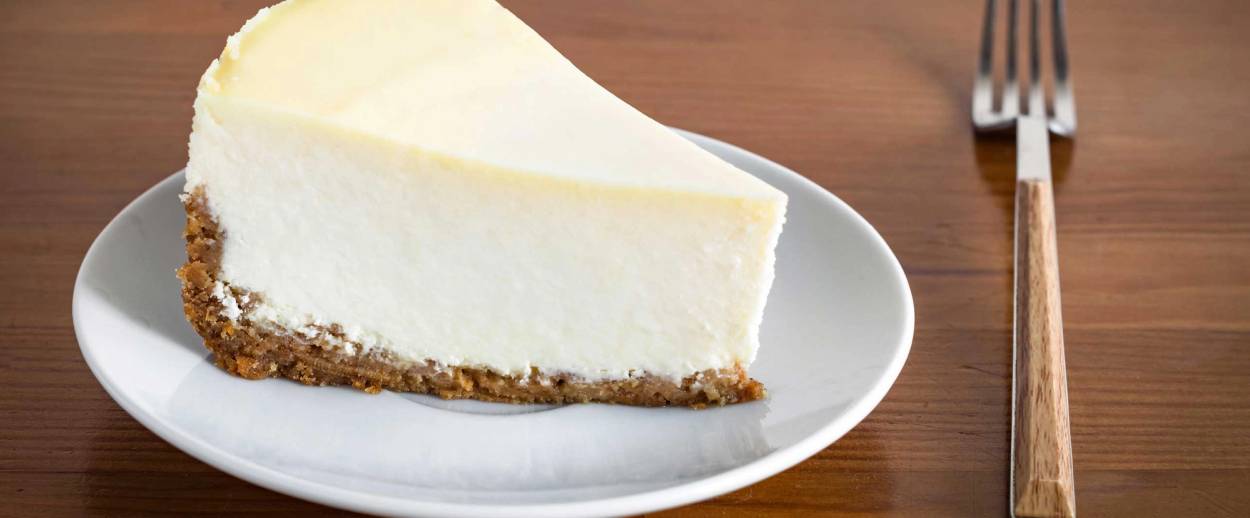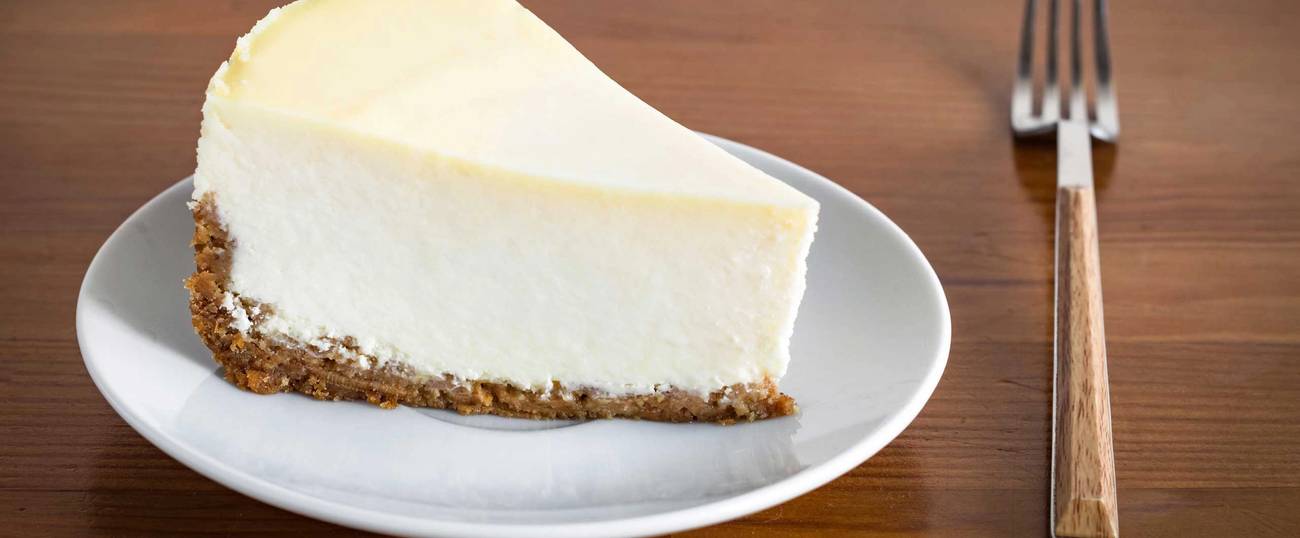On Cheesecake
The traditional Shavuot dessert is held together with memories as much as with cream cheese




My mom is the undisputed queen of cheesecakery. Her cheesecake is flawless: simple graham-cracker bottom, golden sides, none of your salted-caramel mousse or triple-rum piña colada mishegas. Her only deviation from the classic New York standard is a thin layer of sour cream on top. When I was a kid, I’d watch as she unlatched the side of her springform pan, muttering darkly about the crack that almost invariably appeared in the top—the only tiny scar in a landscape of sweet perfection. She’d make it on Shavuot, but also for fancy salmon-y dinner parties (we kept kosher, so it was only an option after milchig meals) and it was amazing, every single time.
She makes it less often now. She’s busy, her kids are grown and gone, it’s a big production, and one of her grandchildren and one of her sons-in-law are lactose-intolerant, which is a shande.
Maxine, my child who is not only lactose-tolerant but lactose-embracing, shares my love of cheesecake. Every Shavuot I ponder making it, and every Shavuot I chicken out, because I am afraid of the springform pan. I do have one. I’m pretty sure it’s a hand-me-down from Mom, actually. It just seems so intimidating—the metal sides that look like they’re needed to corral something untamed and dangerous, the fetish-y metal closure, the whole megillah. (I’m also afraid of soufflé and pie crust, and everyone tells me those are easy, too, so don’t even try; it won’t work. I have a thing.)
I’ve often defaulted to ice cream on Shavuot, because I don’t have to make it, and hey, it’s dairy, so it fits the brief. And my non-dairy-eating fam can fend for themselves or have a Lactaid.
As you probably know, it’s traditional to eat dairy foods on Shavuot. What’s less clear is why. My Jewish Learning has a very entertaining article detailing the various theories about the Shavuot/dairy connection. Because the holiday is simultaneously a harvest festival and a commemoration of the Israelites receiving the Torah at Mount Sinai, the first and most obvious guess about why dairy is that we’re celebrating “a land flowing with milk and honey” (Exodus 3:8). Some lesser-known theories include a kabbalistic one, noting that the Hebrew word halav (milk) has a numerological value of 40 (het=8, lamed=30, vet=2, DO THE MATH, MAN), which is also the same number of days Moses spent on Mount Sinai before returning with the Ten Commandments (did I just blow your mind?). Another wordplay-oriented theory—the Jews love wordplay—notes that Mount Sinai is called gavunim (“multiple peaks”) in the Book of Psalms (68:15), and gavunim shares a root with, or at least the same Hebrew letters as, g’vinah, which means cheese. Of course it does.
For a less speculative look at the history of Shavuot cheesecake, I turned to Leah Koenig, one of my fave Jewish culinary sources (Joan Nathan is the other, because I play no favorites among genius Tablet-contributing food writers). “Cheesecake is unusual because unlike many Jewish foods, it’s definitely an American dish,” Koenig told me. “There were curd cheesecakes made in Europe, but it wasn’t until immigrants came here that the addition of very fatty cream cheese happened.” (If you want to learn the world history of cakes made with cheese, you are welcome to go to Wikipedia, but if you want to know about American-style cheesecake, listen to Leah.)
In the early 1870s, a Chester, New York, dairyman named William Lawrence began making cream cheese for a wide market. Legend has it that he’d been trying to make French Neufchâtel cheese and wound up adding a ton of cream and inventing cream cheese. In fact, cream cheese was an established foodstuff in America in the late 18th and early 19th centuries. But Lawrence was the first person to get real distribution for his product, thanks to industrialization and technological advances (better roads, better storage methods for grain for cattle during the winter, the ability to cylindrical grain test for butterfat content and for bacteria, factory production, wider roads to distribute product, the development of marketing). A New York distributor began calling Lawrence’s product “Philadelphia Cream Cheese,” perhaps because at the time, Philadelphia had a reputation for producing high-quality food. And there you have it: The cream cheese part of the cheesecake.
As for the cake part, its origins are shrouded in luscious, velvety mystery. Arnold Reuben (1883-1970), the German-born American Jew who may or may not have invented the Reuben sandwich—but was definitely good at marketing—may or may not also have invented New York-style cheesecake! He certainly became known for his rendition of it. Today, Reuben’s restaurant is gone; Lindy’s (which supposedly lured away Reuben’s cheesecake baker) is gone; Junior’s is, I’m sorry to say, a shadow of its former self, a purveyor of slightly gummy, too frothy, not-dense-enough cheesecake. Maxie prefers The Cheesecake Factory (don’t be a snob—a lot of their cheesecakes are very good!) and I will always default to Veniero’s, the Italian bakery that’s been in our East Village neighborhood since 1894. Veniero’s makes divine Italian-style ricotta cheesecake (my California sister-in-law’s fave—they ship) and New York-style cheesecake. I also have fond feelings for Veniero’s because the current owner, a descendant of the original owner, was very nice to me and Josie once. We were writing the name of one of the Triangle Fire victims, 16-year-old Jenne Franco, on the sidewalk outside his establishment. As usual, we were participating in the annual CHALK project, in which volunteers write the names of victims in chalk near where they used to live. Sometimes store owners are not delighted to see us crouching to write on their sidewalk or taping up fliers to explain the history of the Triangle Fire and the labor movement to their customers. This guy gave us cookies. He also told us that his family knew Jenne. Go to Veniero’s when you visit New York.
Depending on one’s commitment to Shavuot cheesecake, one might also seek out a Haagen-Dazs strawberry-cheesecake-infused Austrian postal stamp on eBay. Or not. Haagen-Dazs, you may recall, was founded by a Jewish-American immigrant from Poland who decided to name his gourmet kosher-certified ice cream something that sounded Danish, because Denmark was the only country that tried hard to save its Jews during the Holocaust. Ironically, perhaps, Haagen-Dazs today is very popular in Germany and Austria; a German ad agency came up with the notion of a stamp that tasted like Haagen Dazs strawberry cheesecake, and Austrian consumers ate it up. The stamp promotion was supposed to last a month, but the stamps ran out after two weeks.
Or hey, if you really love cheesecake, check out this piece in Cracked magazine: “Nine Things You Can Eat When You’re Hungry at a Porn Store.” (Shockingly, that link may not be safe for your workplace.) As the title says, the writer sought out edible treats in an adult emporium. No one forced him to down an entire shot glass of blueberry cheesecake lube, which he described as “like sucking the life force from the gelatinous eyeball of an Oompa Loompa” and also “not a flavor to enhance sex; this was a sensory abuse to accompany waterboarding.” (Spoiler alert: He vomits.) Also, while Googling to try to ID the product he shotgunned, I discovered that there are two companies that make blueberry-cheesecake-flavored lube. Let that sink in a moment.
Look, I don’t think you need to show quite that level of commitment to cheesecake to celebrate Shavuot. As Koenig pointed out, “There are lots of Jewish communities, like Yemenite Jews, who don’t do dairy on Shavuot at all. On the one hand, for American Jews it’s nice because so much of Jewish cuisine is meat-centric, and Hanukkah and Shavuot roll around as our dairy holidays, but it’s not as if dairy is essential to observing them.”
I asked Koenig about cheesecake for my own non-dairy-eaters. “There is a world of vegan cheeses out there now,” she began, until I furiously interrupted that we have tried both almond and soy cheese and found them vile. She said, patiently, “Well, try vegan ricotta—there are decent ones. And maybe you could do some kind of cheesecake parfait, not baking it, using coconut whip or nice-quality vegan ricotta layered with graham and fruit, so the ricotta doesn’t have to hold a cheesecake shape.”
Or I could just buy both a ricotta and a New York-style cheesecake from Veniero’s, and think warm thoughts of my mom’s cheesecake, and let the non-dairy-eaters celebrate in their own dumb way.
Like this article? Sign up for our Daily Digest to get Tablet Magazine’s new content in your inbox each morning.
Marjorie Ingall is a former columnist for Tablet, the author of Mamaleh Knows Best, and a frequent contributor to the New York Times Book Review.